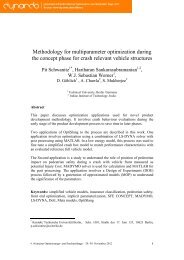multiPlas - Dynardo GmbH
multiPlas - Dynardo GmbH
multiPlas - Dynardo GmbH
Create successful ePaper yourself
Turn your PDF publications into a flip-book with our unique Google optimized e-Paper software.
The global load step bisection can be disabled by choosing a large value for cutmax. In the case of a<br />
local bisection, no hints are written out.<br />
Be careful not to use too large values for maxinc and simultaneous suppression of the global bisection.<br />
This may lead to a large computational effort in a Newton-Raphson-Equilibrium iteration! In this case,<br />
request the cause by use the global bisection!<br />
Multi surface plasticity fundamentally is a physical path dependent phenomenon. Therefore a global incrementation<br />
in order to represent the relocation of force correctly is of utmost importance.<br />
In the multi surface routines, softening (residual strength) is only introduced in at the equilibrium states<br />
(so only after reaching the global Newton-Raphson equilibrium). Therefore, a global incrementing is important<br />
in the case of softening.<br />
The value dtmin in the tb-data-fiel has to be identical to the value of dtmin that is used by ANSYS in the<br />
solution-phase (deltim,dtanfang,dtmin,dtmax,...).<br />
If no convergent solution could be found:<br />
-decrease incrementation (dtmin,...)<br />
-increase the global convergence criteria (cnvtol,f,...)<br />
Newton-Raphson, full (usage of consistent elasto-plastic tangent) or Newton-Raphson, init (starting stiffness)<br />
is supported. For the practical problems Newton-Raphson, init is recommended. Especially when<br />
considering geometric nonlinearities or when working with EKILL / EALIVE the full Newton-Raphson<br />
method is necessary.<br />
47<br />
USER’S MANUAL, January, 2013






